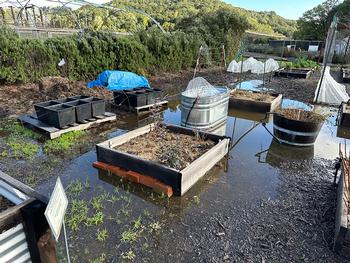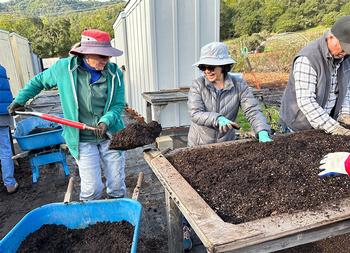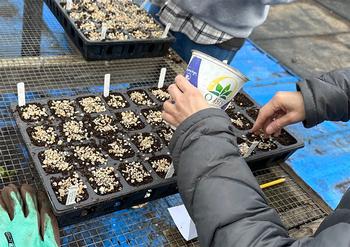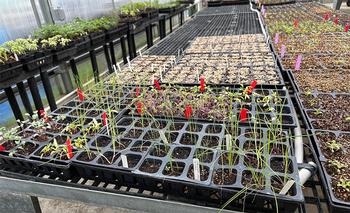News from the Edible Demo Garden
March 2024: Making Soil for Seeds

However, the Edible Demo Garden volunteers are not a group to remain idle, especially when it’s time to start seedlings for the spring and summer garden. The organic seeds for the chosen crops had arrived and they needed to be planted in the proper soil mixture and placed in the greenhouse to germinate. So, on a rare dry day, an enthusiastic group of volunteers met to make soil for growing seedlings.
What soil is best for starting seeds?

Breakfast Mix

- 4 wheelbarrows Lunch Mix (20 cubic ft., already sifted)
- 1 bag Vermiculite (4 cubic ft.) (medium or fine)
- 1 bag Peat Moss (4 cubic ft.)
Lunch Mix
Lunch mix is used for potting up seedlings prior to transplanting or for bigger plants that will remain in 1–3-gallon containers for several months or more. The recipe for lunch mix is as follows. All the ingredients are mixed thoroughly and sifted together.
- 6 wheelbarrows sifted compost
- 1 bag Peat Moss (4 cubic ft.)
- 1 bag Vermiculite (4 cubic ft.) (medium or fine)
- 1 bag Perlite (4 cubic ft.) (medium or fine)
- 10 lbs or 6 qt Azomite (micronized)
- 5 lbs or 5 qt Feather Meal (fine)
- 2.5 lbs or 2 qt Kelp Meal (fine)
What is the purpose of the ingredients in a seedling mix?

- Compost – adds structure, provides nutrients, and contains beneficial microbes
- Peat moss – retains moisture (coconut coir is considered a sustainable alternative)
- Vermiculite – mined mineral, increases soil porosity and adds calcium and magnesium
- Perlite – light, volcanic rock, helps to aerate by increasing pore space
- Azomite – adds trace minerals
- Feather meal – releases nitrogen
- Kelp meal – adds nitrogen, potassium, and phosphorus
Ready to plant
Once the “breakfast mix’ was made, it was used to fill seeding trays and planting could begin. A light topping of vermiculite was added to each cell to maintain the right moisture level.
Click on the following for more information on soil mixes and starting plants from seed:
